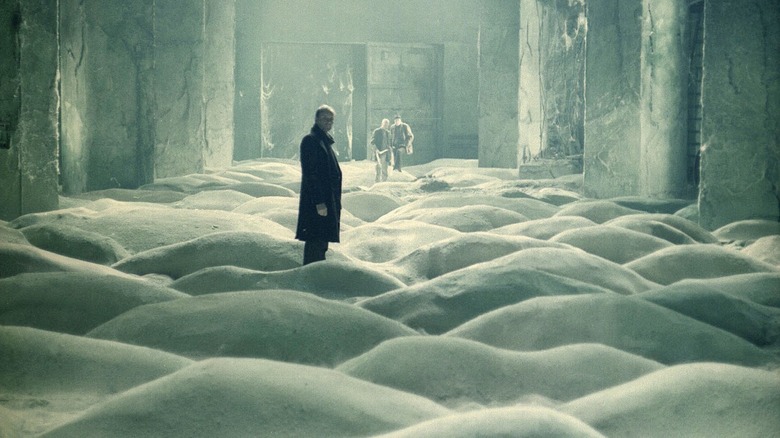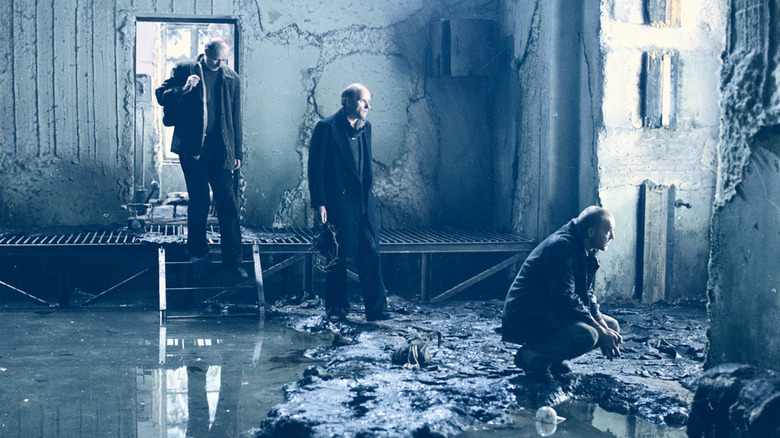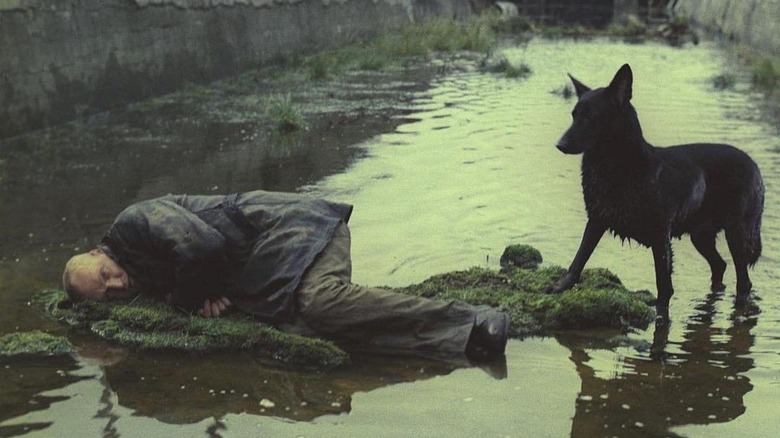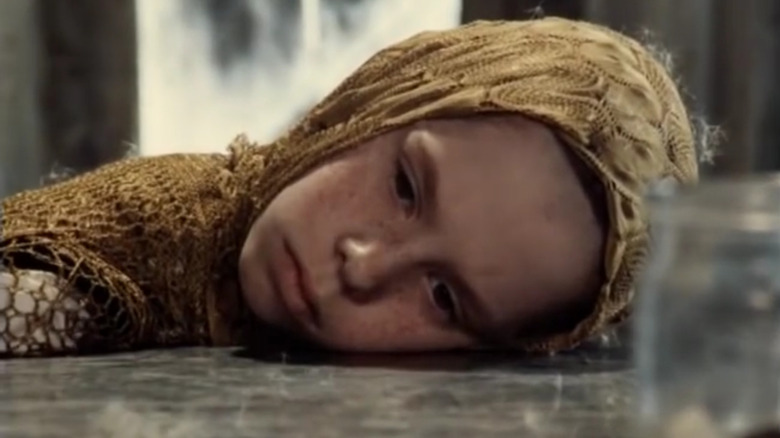Stalker Ending Explained: May Everything Come True
I am often haunted by a 2011 New York Times article called "Eating Your Cultural Vegetables." In the op-ed, author Dan Kois admits to experiencing something akin to an existential crisis when confronted with Kelly Reichardt's feature film "Meek's Cutoff." That film, starring Michelle Williams, is set in 1845 on the Oregon Trail and details the fate of a doomed wagon train. Like all of Reichardt's films, it is quiet, ground-level, and — most notable to Kois — very, very slow-moving. Kois admits that he seeks out slow-moving movies, but only as an object of outsider fascination. He writes that he might feel somewhat, distantly moved by a slow film, but then flies off into the abstract, saying: "But am I actually moved? Or am I responding to the rhythms of emotionally affecting cinema? Am I laughing because I get the jokes or because I know what jokes sound like?"
Kois, like many film audiences, seems to feel that cinema should be an active, engaging art, a pop medium that grabs a viewer with its flashy visuals, interesting characters, or its sociological underpinnings. It is the film's job, he says, to energize, not enervate. When a film moves slowly and dares to invite viewers to, in turn, slow themselves down, Kois implicates that it might be antithetical to the medium.
As a fan of slow cinema, Kois' article has long stood as a direct counterpoint to many of my favorites. If Kois hated "Meek's Cutoff," I can't imagine what he might think of Tsai Ming-Liang's 2020 film "Days," which features an unbroken seven-minute shot of someone sleeping in bed, the works of Lav Diaz, which can run as long as eight hours and often feature extended static shots of black-and-white nature scenes, or Andrei Tarkovsky's "Stalker" from 1979.
Into the Zone
Dan Kois would hate a director like Béla Tarr, whose notorious 1994 drama "Sátántangó" runs 439 minutes, and depicts a long litany of suffering, and Kois would especially hate the works of Andrei Tarkovsky, often hailed as one of Russia's filmmaking masters.
Tarkovsky's first professional feature film was "Ivan's Childhood," made in 1962 and about a young boy who lost his parents in World War II. As Tarkovsky continued to grow as a filmmaker, his work became increasingly abstract, often featuring long scenes of people dreamily discussing philosophy while his camera hangs way back, seeing his protagonists lost in damp or complicated backgrounds. In 1972, he made "Solaris," a heady riff on "2001: A Space Odyssey" about Soviet astronauts who find themselves forming a turbulent psychic connection to a distant planet. "Solaris" is a jaunty 166 minutes, and features many, long, slow shots, including an extended sequence of a car driving through traffic.
For Tarkovsky, sci-fi was the realm of ideas, and he used the genre as a means to open up the deeper recesses of the brain, specifically the seat of paranoia, fear, and anxiety. These themes are further played out in his 1979 film "Stalker," a downbeat, lugubrious, and contemplative stroll through a ruined planet ... and a trio of ruined minds.
"Stalker" takes place in a unnamed country in an unspecified future year. A professional "Stalker" (Alexander Kaidanovsky) is hired by a Writer (Anatoly Solonitsyn) and a Professor (Nikolai Grinko) to lead them into a mysterious, dangerous nature preserve called The Zone. The Zone is said to be covered with active mines, but at the center, there is rumored to be a free-standing room that will perhaps grant its occupant a wish.
A Stalker, a Writer, and a Professor walk into a Zone...
Dan Kois would be driven mad by the deliberate process the three protagonists take through The Zone ... as would most people. In order to test for mines, the three men toss a small, weighted gunny sack a few feet in front of them at a time, then walk very slowly after it. Occasionally they will stop to express despair and then continue on. The landscape is not futuristic, nor post-apocalyptic. It's merely a ruined country, affected by some unknown cataclysm. A casual observer, of course, will see that The Zone represents the forbidden area surrounding Chernobyl after its nuclear disaster.
Even fans of slow cinema will have to test their patience with "Stalker." This is a slow slog through a land of death, and Tarkovsky's earthy greys and washed-out skies give the impression that humanity is fading out in earnest. There is a note of entropy at play, of evolutionary stagnation. The only thing keeping humans moving forward is the vague promise of hope. The Writer eventually reveals that his wish will be a further inspiration. Human creativity, it seems, has also run dry. The Professor, meanwhile, aims for intellectual glory, hoping to win a Nobel Prize for his study of The Zone. Magic is required to spread information. The Stalker just wants to help people, although he will eventually reveal what happened to the previous Stalker.
One might be forgiven for being pushed into their seats and even for feeling drowsy during "Stalker." Its hypnotic tone, constant use of slow motion, and very scant editing seem designed to lull a viewer into a semi-dream state. Some trivia: in its 161 minutes, there are only 142 shots.
The future of humankind
"Stalker" ends in a bizarre moment of the fantastical. After returning from The Zone — they each elect not to make any wishes (argh!) — the Stalker talks with his wife, explaining that humankind is doomed, there is no hope nor faith, and that all is lost. Even with access to magic, there is no wherewithal to use it. Tarkovsky's nihilism isn't bitter or adolescent, but a sad lamentation. "Stalker," in tone, pace, and theme, is a funeral march. Humanity bears its own pall. Then, after the Stalker goes to bed, and after his wife (Alisa Freindlich) contemplates their doomed relationship, their young daughter (Natasha Abramova) sits alone. She stares at a few glasses, and they move. She seemingly had telekinetic powers. Cut to black.
This final sequence, one might interpret, is a dramatization of humanity's next step. In a world of hopelessness and stagnation, growth and evolution are still happening. A young girl, like the Star Child from "2001: A Space Odyssey" represents the new evolutionary plane of our species. After living in Grey Hell for over two and a half hours, one can finally see a glimmer of color. Tarkovsky seems to be arguing that humanity in 1979 was passing through its darkest period. The Soviet-Afghan War was about to begin, and the Soviet Empire was certainly poised to collapse (which it did in 1991).
A new generation, however, will enter with a new psychic language, and — one hopes — lead us to new places.
It's a gentle catharsis, and one that requires a lot of patience to absorb, but there is a thematic chord that Tarkovsky strikes with "Stalker." It may be challenging, and not deeply moving, but there is an idea just underneath the ashen fields.



